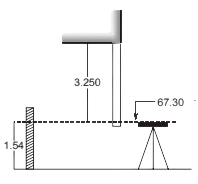LEVEL FIELD BOOK
- It is the book used for entering the staff readings and reduced levels of various points.
- For computation of reduced levels of various points, two methods are used :
(a) Height of instrument / height of collimation method.
(b) Rise and fall method
Height of Instrument Method (Height of Collimation Method)
- The height of collimation is determined by adding the staff reading, which must be a backsight to the known reduced level of the point on which the staff stands.
| HI Method/ Height of collimation method | ||||||
|---|---|---|---|---|---|---|
| Station (1) | BS (2) | IS (3) | FS (4) | HI (5) | RL (6) | Remarks (7) |
|
A |
1.350 | 101.350 | 100 | BM | ||
| B | 2.150 | 101.350 |
99.2 |
|||
- The first reading is always back sight.
- The last reading is always fore sight.
- Station at which both BS and FS readings are taken implies that it a change point i.e. instrument is shifted after taking the BS.
- Arithmetic check : After computation of all the levels, the following arithmetic check is applied :

Rise and Fall Method
| Rise and Fall Method | |||||||
|---|---|---|---|---|---|---|---|
| Station (1) | BS (2) | IS (3) | FS (4) | Rise (5) | Fall (6) | RL (7) | Remarks (8) |
|
A |
1.350 | 100 | BM | ||||
|
B |
2.150 | 0.8 | 99.2 |
|
|||
- The first four and last two columns are exactly same as HI method.
- Here instead of column for HI, two columns of rise and fall are there.
- Here rise or fall of each station is determined w.r.t. previous station.
- Arithmetic check : After computation of all the levels, the following arithmetic check is applied :
![]()
Note:
Use of Inverted Staff
When the point, whose elevation is to be found, is much above the line of collimation (e.g. projection from the face of a building, underside of beams, girder and arches etc.), the staff is placed inverted with its zero end tou ching the point.
ching the point.
The inverted staff reading is booked in the relevant column of the level book with a negative sign such that when reducing this reading from the height of collimation of the level we get,
R.L of soffit = 67.3 – [–3.25] = 70.55 m
<< Previous | Next >>
Must Read: What is Surveying?
WhatsApp Group
Join Now
Telegram Group
Join Now

